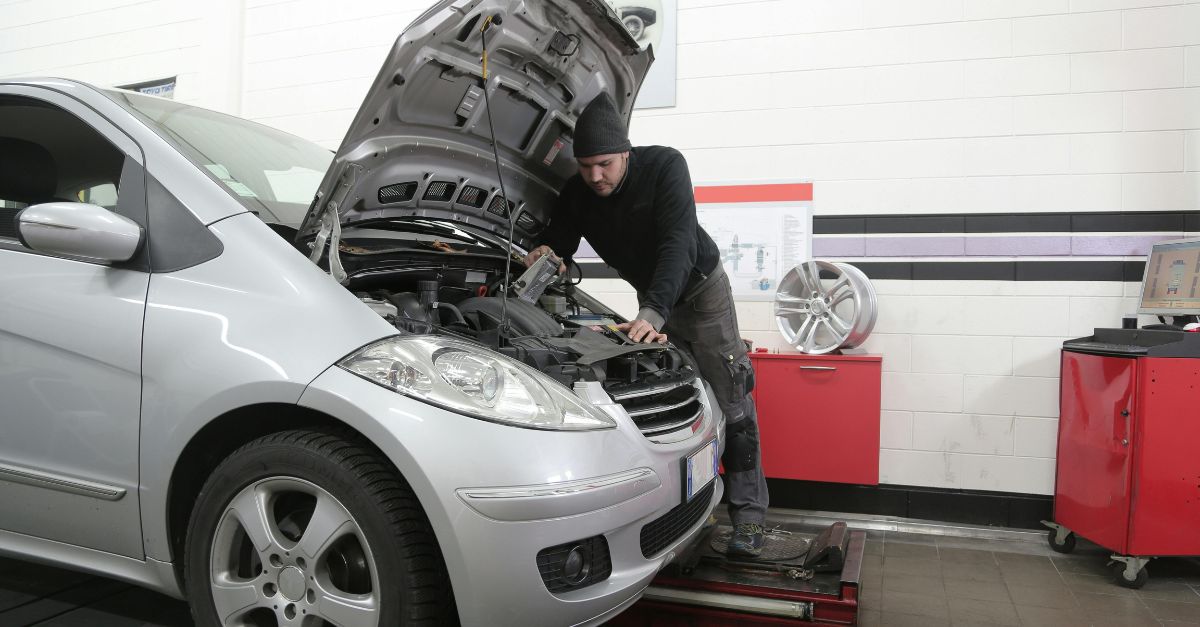Skip These Services
Every repair shop has a list of "recommended" services that they insist your car needs. But does it really? Here are some frequent unnecessary common car repairs that might be emptying your wallet without providing much benefit.

Premium Fuel For Regular Cars
Premium fuel is said to have an octane rating between 91 and 94, while regular fuel is around 87. The higher octane in premium helps it avoid knocking, which is basically when the fuel burns too early. This is important for high-performance engines.
Premium Fuel For Regular Cars (Cont.)
Conducted tests have shown that using premium fuel might give your car a minimal boost in horsepower or fuel efficiency. But honestly, those improvements are usually so minor that they don't make the higher price worth it for most cars.
Cat-Back Exhaust System
One of the most notable changes with a cat-back system is the increase in exhaust noise, which can be annoying to some. While cat-back systems also promise increased horsepower, the gains are often small, typically ranging from 5 to 15 HP.
 How To: Install a CatBack Exhaust System by Luca Car Mods
How To: Install a CatBack Exhaust System by Luca Car Mods
Cat-Back Exhaust System (Cont.)
A lot of aftermarket cat-back exhaust systems can actually weigh more than the original parts. This extra weight can offset a certain amount of the performance gains you get from better exhaust flow, especially if you've got a smaller or lighter car.
Headlight Upgrades
Not every vehicle can easily handle secondary market headlight upgrades. Some might need extra tweaks or wiring changes, which can make the installation trickier and raise the costs. Incorrect wiring can also result in fatal electrical issues or malfunctioning lights.
 Changing a Car Headlight : Change a Car Headlight by ExpertVillage Leaf Group
Changing a Car Headlight : Change a Car Headlight by ExpertVillage Leaf Group
Headlight Upgrades (Cont.)
Switching to modern lights like LEDs or HID (High-Intensity Discharge) might give you a brighter, more concentrated beam. But then, many cars already have quite good lighting for regular driving situations. Some drivers just upgrade their headlights for aesthetics.
Spark Plug Replacement At Short Intervals
Modern spark plugs, especially those made from iridium or platinum, tend to last longer than the old copper ones by a long shot. Companies like Toyota and DENSO recommend replacement intervals of up to 100,000 miles for these advanced spark plugs.
 Spark Plug Replacement DIY (the ULTIMATE Guide) by ChrisFix
Spark Plug Replacement DIY (the ULTIMATE Guide) by ChrisFix
Spark Plug Replacement At Short Intervals (Cont.)
Many service schedules mix time-based intervals with mileage suggestions, such as suggesting service every 60 months. This can be a tad confusing, especially for cars that don't get driven much and might not seriously wear down their spark plugs over time.
 Spark Plug Replacement DIY (the ULTIMATE Guide) by ChrisFix
Spark Plug Replacement DIY (the ULTIMATE Guide) by ChrisFix
Coolant Flush
This is a maintenance procedure wherein you remove the old coolant from a vehicle's cooling system and replace it with a fresh one. However, if low-quality coolant is added after a flush, it might not give proper protection against corrosion or overheating.
 How to Quick Flush Your Cars Cooling System by ChrisFix
How to Quick Flush Your Cars Cooling System by ChrisFix
Coolant Flush (Cont.)
When drivers are told they need a coolant flush, it's because they're dealing with issues like overheating or their car just not running well. But sometimes, these problems can actually come from other things, such as a broken thermostat or leaks in the radiator.
 How to Quick Flush Your Cars Cooling System by ChrisFix
How to Quick Flush Your Cars Cooling System by ChrisFix
Brake Fluid Flush
In older cars with significant built-up in the brakes, flushing the system tends to release debris that might clog other parts, like the calipers or ABS modules. Also, newer vehicles come equipped with advanced braking systems that are made to be less prone to moisture absorption.
Fuel Injector Cleaning Services
Modern fuel injection systems do a good job of cleaning themselves. Each injector nozzle works at high pressure and sprays fuel through tiny holes that are a few inches wide. Plus, quality gasoline has up to five times more detergent than the EPA requires.
 How To Clean Fuel Injection Systems - Fuel Injector Service - OTC 7448 by The Car Doctor
How To Clean Fuel Injection Systems - Fuel Injector Service - OTC 7448 by The Car Doctor
Fuel Injector Cleaning Services (Cont.)
In case your car's running rough, hesitating, or misfiring, it might need a clean, but you could just try an affordable bottle of quality cleaner first. Getting a professional cleaning can set you back $150-300, and it usually doesn't help much, to be honest.
Battery Replacements
Don't rush to replace your battery just because it's three or four years old. Nowadays, batteries can last anywhere from 5 to 7 years if you take care of them. Regular tests, such as Voltage or Load, give you an idea of its health rather than going by age.
 Easy Process to Change the Battery on your Car by Got it done!
Easy Process to Change the Battery on your Car by Got it done!
Battery Replacements (Cont.)
Hot weather can drain the battery life, while cooler temps can help it operate longer. If your car is slow to start, then you definitely should check its battery. But remember, some aftermarket options do not offer the same reliability or lifespan as original ones.
Unnecessary Oil Additives
According to Machinery Lubrication, if you choose high-quality lubricants from reputable manufacturers, additional additives often give little to no benefit and can sometimes even detract from the oil's performance. For most everyday drivers, premium oils are sufficient for engine health.
Unnecessary Oil Additives (Cont.)
Adding secondary market oil additives can negatively affect the carefully balanced formulation of the oil, leading to adverse effects. For example, increasing the concentration of one type of additive might improve a specific property while degrading another.
 Dvortygirl, CC BY-SA 3.0, Wikimedia Commons
Dvortygirl, CC BY-SA 3.0, Wikimedia Commons
Unnecessary Oil Additives (Cont.)
Relevant research has shown that certain additives can increase the viscosity of the oil beyond acceptable limits, which can impair cold-flow ability and the car's overall lubrication performance. These additives could essentially hinder engine operation.
Wheel Alignments
It's not mandatory to get your wheels aligned every time you change the tires. Once in a while, or after hitting a huge bump, it makes sense to get it done. TATA AIG suggests checking alignment every 10,000 miles or as specified by the vehicle's manufacturer.
Radiator Cap Replacements
The radiator cap is a key part of your car's cooling system. It helps keep the right pressure and temperature to stop the engine from overheating. In discussions on Car Talk, mechanics have reported that they rarely replace radiator caps.
 How to Replace Radiator Cap 1992-1996 Toyota Camry 2.2L I4 by TRQ
How to Replace Radiator Cap 1992-1996 Toyota Camry 2.2L I4 by TRQ
Radiator Cap Replacements (Cont.)
They only do it if there is a specific problem linked to the cooling system. Radiator caps can be tested for pressure retention using specialized equipment, which provides a more accurate assessment of their condition without needing to replace them preemptively.
 How to Replace Radiator Cap 1992-1996 Toyota Camry 2.2L I4 by TRQ
How to Replace Radiator Cap 1992-1996 Toyota Camry 2.2L I4 by TRQ
Frequent Power Steering Flushes
Some sources recommend changing the power steering fluid every 30,000 to 50,000 miles as part of regular maintenance. Doing this helps clear out any particles or contaminants that build up over time. In turn, this keeps your car's power steering working smoothly.
 How to Flush a Power Steering System -- EASY! By 2CarPros
How to Flush a Power Steering System -- EASY! By 2CarPros
Frequent Power Steering Flushes (Cont.)
For instance, the power steering fluid in a Toyota should be changed at least once every two years. Stiff steering or strange noise doesn't always mean the fluid needs changing. Those signs can come from other problems, like worn-out parts or leaks.
 How to Flush a Power Steering System -- EASY! By 2CarPros
How to Flush a Power Steering System -- EASY! By 2CarPros
Frequent Power Steering Flushes (Cont.)
Now, suppose your power steering fluid looks dark or smells burnt; that's a clear sign it's gone bad and probably needs to be changed. Fresh power steering fluid should be fresh and clear, usually a bright red or pink color, depending on what type is being used.
 How to Flush Your Power Steering Fluid by ChrisFix
How to Flush Your Power Steering Fluid by ChrisFix
Serpentine Belt Maintenance
Modern serpentine belts are often made from EPDM (Ethylene Propylene Diene Monomer) rubber, which is far more durable and resistant to heat, oil, and ozone than older materials. This allows them to last longer—often exceeding 100,000 miles under normal driving conditions.
Serpentine Belt Maintenance (Cont.)
Rather than replacing serpentine belts solely based on mileage, a visual inspection can serve as a more accurate assessment of their condition. Drivers should regularly check for small fissures, space between the ribs, splits in the belt, or if the belt is constantly slipping.
 How To Replace A Serpentine Belt by Mechanic Gone Rogue
How To Replace A Serpentine Belt by Mechanic Gone Rogue


















